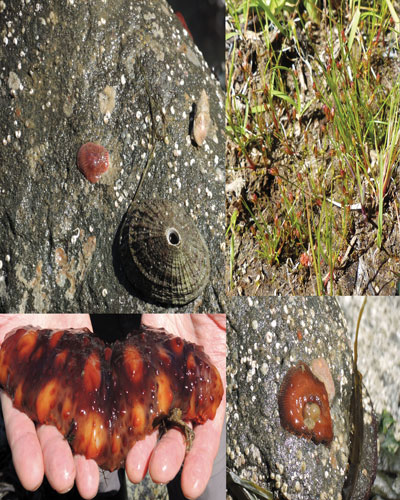Albert Head combed for rare species and vegetation
By Lookout on May 16, 2016 with Comments 0

(background) A Keyhole Limpet (Hemocyanin), is attached to a large rock that was pulled from a tidal pool.
(top right) Photo by Metchosin Biodiversity Project
Biodiveristy project botanists took a photograph of this patch of rush discovered at the training centre which they believe to be a rare species known as Juncus Kelloggii. A sample of the plant is undergoing further analysis by the group before its authenticity can be confirmed.
(bottom left)
Photos by Peter Mallett, Lookout
A Giant California Sea Cucumber (Parastichopus Californicus) is another animal found in shoreline waters.
Peter Mallett, Staff Writer ~
A team of roving scientists and researchers invaded the Department of National Defence Albert Head property last Monday.
It wasn’t a hostile takeover, but part of a “Bioblitz” event organized by the Metchosin Biodiversity Project.
The invasion was an effort to document the wide-ranging native and rare species of plant and animal life at the 220-acre Westshore facility.
Over a three-hour period on May 9, 15 members of the Metchosin Biodiversity Project fanned out across the sprawling DND property to catalogue all the species they came across.
Participants were divided into three teams: spider and insects, fungi and botany, and marine life. Moralea Milne, co-founder of the group, said the site is of particular interest because it has an undisturbed swath of the Gerry oak ecosystem, which is one of the three rarest ecosystems in Canada.
It is also home to a number of rare species designated as endangered or threatened under the federal government’s Species At Risk Act (SARA).
“Some of the best places to look for rare and endangered species is on DND properties,” added Andy MacKinnon, another founding member of the project.
“That’s because military properties in Canada and the United States have a huge range of diversity of species as they have remained military bases over many years and have not developed much of their land.
Also it appears DND is going out of their way to protect and preserve their biodiversity.”
The Metchosin Biodiversity Project was founded in 2011 and so far has catalogued 2,200 plant and animal species.
During their visit, four members of the marine life group travelled to the south portion of the property to explore a large tidal inlet.
The intertidal area was teeming with life. Just before the tide began to rush back into the inlet, three members of the group, wearing rubber boots, waded between the giant basalt rock formations
One of the waders, Phil Lambert, a former marine invertebrate curator at the Royal B.C. Museum, uncovered a Brooding Sea Anemone.
His wife Marilyn, also a former curator with the Royal B.C. Museum, took detailed notes of Lambert’s findings and those of his partners Kem Luther, a science writer and naturalist, and Garry Fletcher, a retired science teacher at Pearson College.
Some of the other plant and animal life found included: a large limpet called a Keyhole Limpet, a giant marine mollusk called a Gumboot Chiton, an abundance of Purple Shore Crabs and other 10-legged marine crustaceans, Bay Mussels, Giant California Mussels, and Gooseneck Barnacles.
Up on dry land, and closer to the main gate, Ryan Batten and the team of botanists uncovered what they believed to be a rare find of Juncus Kelloggi, also known as Kellogg’s Dwarf Rush growing in a low-lying sun-drenched clearing. Milne said the finding is still undergoing analysis.
The species of rush is currently known to exist in only one other location in Canada.
Tracy Cornforth, who works within the Base’s Formation Safety and Environment Branch, helped facilitate the visit and noted the efforts of the biodiversity project and their findings will also be of value to the Canadian Armed Forces (CAF).
“Having all of these experts here [at Albert Head] is of great benefit to the CAF too because it helps us gain a greater understanding of species that are thriving on this property,” said Cornforth.
“The more we know about the plant and animal life, the more we are able to manage our land and make better-informed decisions about activities on the base, and where they can happen.”
Preparing a list of the species catalogued at the Albert Head Bioblitz is time consuming work and may not be available for several days, but Milne encourages anyone interested in learning more about the group and its efforts to visit their website: http://metchosinbiodiversity.com
Filed Under: Top Stories
About the Author:





